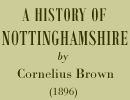< Previous | Contents | Next >
Scrooby
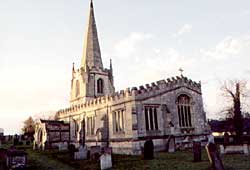 St Wilfred's church, Scrooby, dates from the late
medieval period (A. Nicholson, 2001).
St Wilfred's church, Scrooby, dates from the late
medieval period (A. Nicholson, 2001). THERE are few rural villages with which the early history of the colonization of the United States is entwined in so interesting a manner as it is with that of Scrooby, a little cluster of cottages surrounded by a few larger residences near the Great Northern Railway, between Retford and Bawtry. The tiny river Ryton still runs its course, as it has done for centuries, spanned at one end of the village street by a water-mill, the ancient stones of which bear the names of the people who cut them in 1710.
Scrooby, now so little noticed, was once the seat of the Archbishops of York, and, curiously enough, in its old archiepiscopal mansion the leaders of the Pilgrim Fathers met ere they had completed their project for colonizing New England. Thoroton, referring to the Archbishops’ palace here, compares it with that at Southwell, and says it was ‘a better seat for provision than Southwell.’ In Doomsday Book it is entered as the Archbishop of York’s manor, and in 1270 allusion is made to it in the register of Archbishop Giffard. The building seems to have been added to from time to time till it became a large and comfortable residence. Henry VIII., on his way into Yorkshire, sojourned a night here, and the magnificent Cardinal Wolsey made several visits in the heyday of his prosperity. On the eve of his downfall also he spent some time at this pleasant but secluded home on his last lingering journey northward. Bonner, afterwards Bishop of London, dates a letter ‘at Scrooby, with my Lord’s Grace,’ in 1530,t to Cromwell, asking for the loan of some Italian books. After leaving Scrooby, Wolsey proceeded to Cawood, and was there arrested: As to the dimensions of the residence, Leland gives us some idea in his ‘Itinerary,’ where he speaks of it as ‘a great manor-place, standyng within a mote, and belonging to the Archbishop of York, buildid yn to courtes whereof the first is very ample.’
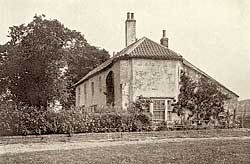 Scrooby Manor House marks the site of the medieval
manor house of the Archbishop of York. This building was largely demolished
in 1636-7, though one wing survived and in the mid-18th century was
converted to a farmhouse for the Archbishop's tenant: this is the
building seen above. (A. Nicholson, 2001).
Scrooby Manor House marks the site of the medieval
manor house of the Archbishop of York. This building was largely demolished
in 1636-7, though one wing survived and in the mid-18th century was
converted to a farmhouse for the Archbishop's tenant: this is the
building seen above. (A. Nicholson, 2001).The village occupied an important position in the coaching days, for it was on the Great North Road, and was the stage between Tuxford and Doncaster. In the time of Archbishop Sandys, who died at Southwell, in 1588, one Brewster held the office of postmaster, and he was succeeded at a farm there by his son William, a tenant of Sir Samuel Sandys, who had been granted a lease of the manor by his father, the Archbishop, on exceptionally favourable terms.
William Brewster, the son of the postmaster, had been well educated, having been at the University of Cambridge, after which he became attached to Sir William Davison, the Ambassador to the Low Countries. In 1587 he retired to Scrooby, and it is now that we get our first glimpse of the Pilgrim Fathers there.
Some doubt has been expressed whether William Brewster was the son of the Scrooby postmaster or the son of the Vicar of Sutton-cum-Sound, also named Brewster, and the writer of the able article on our hero in the ‘Dictionary of National Biography’ also raises the point. An entry in the State Papers fortunately throws a flood of light upon it. It seems that when the postmaster died in 1590 his son applied for the post, which was conferred on Samuel Bevercotes. Sir John Stanhope, writing to Secretary Davison, gives reasons why he did not appoint ‘young Bruster,’ and on the back of the correspondence which passed between them there are notes in Davison’s hand urging the claims of his protege, the Cambridge scholar, to the position. Davison apparently kept up his interest in Brewster, for the latter eventually obtained the office, as is shown in an entry of payments made to him until 1607.
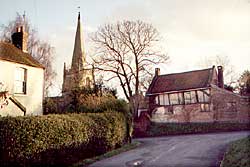 The timber-framed old vicarage in Scrooby was
built most probably in the late 16th century. It was known as Brewster's
Cottage in the 20th century, without much evidence of a link with
the man. (A. Nicholson, 2001).
The timber-framed old vicarage in Scrooby was
built most probably in the late 16th century. It was known as Brewster's
Cottage in the 20th century, without much evidence of a link with
the man. (A. Nicholson, 2001). In his retreat at Scrooby, Brewster developed a strong bias towards Puritanism. But Puritanic principles found little favour with James I., and the strong arm of the law was invoked to put down the leaders of the movement. In 1608 Brewster fell into trouble for conscience’ sake, and was fined £20 for not appearing when summoned before the Commissioners for Ecclesiastical Causes at Southwell.
About this time a congregation of Puritans met at Scrooby, and John Smyth, once curate of Gainsborough, and Richard Clyfton, who had held the livings of Marnham and Babworth, were the ministers. Tradition says that they worshipped in one of the outbuildings of Brewster’s house, and, as the influence of the little community spread, they were joined by William Bradford, a sturdy yeoman, of Austerfield, and the Rev. John Robinson, whose name has been handed down to posterity in honourable connection with the settlement of New England. The circumstances which led to the flight of the Puritans to Holland, their return, and resolve to find a home in a new country across the great Atlantic, are written in the histories of the Old and the New Worlds, and there is no need to detail them here.
In Virginia the Governor was Sir Edwin Sandys, a brother of the owner of Scrooby and of Brewster’s old landlord. Communications took place with him for permission to be granted to the Pilgrims to establish themselves upon the shores of North America. On August 5, 1620, the Mayflower set sail from Southampton, and Brewster, the oldest of the Pilgrims, was one of the principal leaders of the expedition, his friend Bradford, of Austerfield, being his companion and biographer, and furnishing the details of the early stages of the project which was destined to have such mighty issues. A chair formerly used by Brewster is still preserved in Pilgrim Hall, Plymouth, and his sword is in the cabinet of the Massachusetts Historical Society.
Some little time after Brewster had left the old palace to seek freedom in Holland the buildings were demolished. The Archbishops had ceased to resort there, and we presume the house, and especially the wooden portions of it, were falling into decay. Thoroton speaks of it as having stood ‘within memory,’ so that it would be taken down about 1620, or very soon after Brewster’s tenancy came to an end. The large gateway was removed, and the park, which had fed much venison for the Archbishop’s table, was divided into farms. The site, however, is still very clearly defined. The palace stood in the large field near the station, which is bordered by the line of railway on the east and the river on the north. The moat is plainly to be seen, and the site of the fishponds can readily be traced. On the north of the field, near the river, there stands a farmhouse and outbuildings, which were put up some time after the palace was destroyed. The walls of the house are very thick, and it has a substantial though somewhat quaint appearance. The end is towards the field and the front looks into a garden, in which stood, until very recently, an old mulberry-tree, said to have been planted by Cardinal Wolsey. The outbuildings are at the end of the garden, and a short distance from the front of the house. The courteous occupier of the farm, who showed us round the place, pointed out some carved oak beams in the sheds, very solid and very strong, and said that these were taken from the palace at its demolition. He mentioned that eminent Americans often visit this birthplace of the great Puritan movement, and years ago one of these carved beams was sent over to the new country to be treasured amongst its relics.
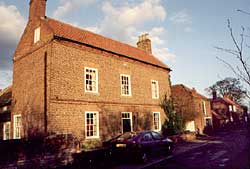 Low Farm, Scrooby, dates from the late 18th century.
(A. Nicholson, 2001).
Low Farm, Scrooby, dates from the late 18th century.
(A. Nicholson, 2001). No other portions of the ancient fabric remain, nor could we trace any memorials of the Sandys family, save a stone in the floor of the church, whereon is the following inscription: ‘Here lyeth ye body of Penelope Sandys, daughter of Sr Marten Sandys, obyt 25 of December Anno Dom. 1690.’
But the temptation is irresistible to linger awhile on this famous spot and to reflect on the progress of a movement which, starting like a tiny rivulet in this little hamlet of our county, broadened and deepened till it overflowed a continent with its swiftly-flowing streams. The Rev. John Raine, a cultured and able antiquary, has done much to bring to light the parochial records of the parish of Blyth, of which he was the Vicar. Few villages have the important events connected with them treated in so interesting a form as is found in his ‘History of Blyth,’ and it may well serve as an example for other learned incumbents to follow.
